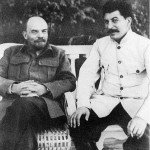
The world knows Joseph Stalin as a brutal dictator who ruled the Soviet Union from the late 1920s to his death in 1953. In the first years of the Bolshevik regime, however, very few thought Stalin a likely successor to Lenin. The contrasts between the two were significant. Lenin had emerged from middle-class; he was well educated, an intellectual who worked extensively, spoke fluently and wrote enormous volumes. In contrast, Stalin was a crude Georgian of peasant stock. He was short but physically strong; he was coarsely spoken and overbearing; his face was scarred by a bout of childhood smallpox. The young Stalin, who was born Josef Jugashvili, had been an excellent student – but he was not an articulate speech maker, nor was he particularly worldly (for many years he believed that Holland and the Netherlands were different countries).
In his youth, Stalin trained for the priesthood. Despite this, or perhaps because of it, he had a chauvinistic disregard for women and a strong racial hatred of Russia’s Jews. This anti-Semitism, combined with competition for position in the Bolshevik party, contributed to Stalin’s intense dislike for Trotsky (the pair loathed each other from their first meeting). Stalin was a minor player in the Bolsheviks until the 1920s. Prior to World War I, he had organised and conducted bank robberies to fund the party’s activities. He was also involved in inciting strikes and protests, gang violence, running protection rackets and possibly arson and sabotage attacks on government buildings.
At the time of the February Revolution, Stalin was co-editor of Pravda and one of the leading Bolsheviks in Russia (though only by default, as a dozen other higher ranked Bolsheviks were in exile abroad). Stalin’s initial response was to write and publish articles that called on the Bolsheviks to support for the Provisional Government. He maintained this position until the return of Lenin in April 1917. Through 1917 Stalin’s position within the party began to rise, chiefly because of his work for Lenin. He assisted Lenin’s flight to Finland after the failed July Days uprising, and for a time served as the nominal Bolshevik leader within Russia. Stalin also earned Lenin’s trust and became something of a ‘fixer’ or ‘go to’ man, someone who could carry out instructions reliably and effectively, though not necessarily someone capable of giving instructions.
In 1922 Stalin was appointed as the party’s general secretary, a seemingly minor position but one that enabled him to oversee and manipulate party appointments. He filled the Orgburo and key leadership positions with friends and acolytes while working behind the scenes to forge alliances within the Politburo itself. Lenin, by now desperately unwell, effectively housebound and participating less in government, grew suspicious of Stalin. The Bolshevik leader became critical of Stalin’s personal qualities (a view famously expressed in Lenin’s political testament). Stalin was aware of Lenin’s high position in the party so publicly pledged obedience and loyalty, while working behind the scenes to undermine and isolate the Bolshevik leader.
On Lenin’s death, Stalin took a lead role in giving public commemorations, organising his funeral and (against Lenin’s wishes) ordering that his body be embalmed and placed on public display. Stalin formed a troika – a three-way alliance with Kamenev and Zinoviev – and with their support, assumed effective control of the Bolshevik party. The rise of Stalin ushered in the bloodiest period in Russia’s history, with war, industrialisation, collectivisation of farms, famine and class war leading to the deaths of as many as 20 million people. Whether Stalin was a deviation from Lenin’s example or a continuation of it is a hotly disputed question amongst historians of Russia.
© Alpha History 2014. Content on this page may not be republished or distributed without permission. For more information please refer to our Terms of Use.
This page was written by Jennifer Llewellyn, John Rae and Steve Thompson. To reference this page, use the following citation:
J. Llewellyn et al, “The rise of Stalin” at Alpha History, https://alphahistory.com/russianrevolution/rise-of-stalin/, 2014, accessed [date of last access].
